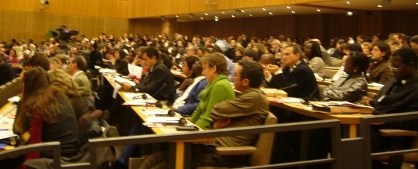Microfinance for agriculture - FARM’s conference 2007
From December 4 to 6, FARM and the Institut de la Gestion Publique et du Développement Economique (IGPDE)organized in Paris the conference "What microfinance for agriculture in developing countries ?"
![]() Outlining the question of agriculture financing and microfinance contribution
Outlining the question of agriculture financing and microfinance contribution![]() Preliminary conclusions by Solène Morvant at the final session of the seminar
Preliminary conclusions by Solène Morvant at the final session of the seminar![]() Available documents
Available documents![]() PROCEEDINGS ARE AVAILABLE (pdf, 350ko)
PROCEEDINGS ARE AVAILABLE (pdf, 350ko)
Outlining the question of agriculture financing and microfinance contribution
Despite the many microfinance initiatives aimed at reducing exclusion from financial services in developing areas, the problem of financing agriculture is still very acute. For this reason FARM chose to take a close look at what role microfinance can play and how can it intervene to improve agriculture’s access to financial services. These questions were at the center of the debate at FARM’s conference on December 4-6,2007, entitled "What microfinance for developing countries’ agriculture ?"
In developing countries, three-fourths of the people live in rural areas. For their livelihood, these people strongly depend – directly or not – on agricultural activities.
Between 60-99% of rural households earn a living from farming, even if it is rarely the only source of income for households. Most of these individuals also earn wages either in the agricultural sector or other sectors, are self-employed (shopkeepers), or receive money from family members who have emigrated to cities or abroad. Family farming is characterized by a low productivity due in particular to low levels of investment in inputs (fertilizer, phytosanitary products, herbicides) or in equipment. But such investments require access to financial sources in the form of short, medium or long term loans. But farm families often live from city centers, and with low monetary incomes find it difficult to qualify for loans. These are significant obstacles for the development of financial services that are accessible and adapted to a population which is poor in monetary forms, whose survival is dependent on a number of exogenous factors, like climate, crop disease, or price movements, and the like.
In this context, numerous initiatives in microfinance aimed at helping rural populations, who have heretofore been excluded from access to financial services, have become a source of hope for agricultural financing in developing countries. But the reality remains that significant inequalities in financial service access are still prevalent, not only among different regions(1) but also in agriculture as distinct from other sectors.
Establishing financial services in out-of-the-way areas with low population density and which lack basic infrastructure (roads, electricity, health centers, and the like) is truly a challenge. When in addition the target activity is agriculture, the challenges only increase due to the riskiness and low profitability associated with this sector. For these reasons, microfinance has not been able to respond to more than a small fraction of the needs of agriculture in developing countries for financial services.
Drawing farmers in the global south into the world of banking is far from accomplished, and the challenge is huge. From various initiatives that have been carried out in different contexts, there are legitimate questions about how to adapt microfinance to agriculture and under what conditions can microfinance have a real impact on agricultural development.
(1) Although there are some 3000 microfinance institutions serving more than 100 million clients around the world, it must be noted that the rate of coverage of the population ranges from 47% in Asia to 9.5% in Africa.
The conference took place in the Pierre Mendès France Conference Center at the Ministry of Economy, Finances and Labor, and the Ministry of the Budget, Public Accounts and Civil Service. About 350 participants from different countries of Africa, South America, Asia and Europe were present. The two and half days were grounded on three plenary sessions and six workshops.
Several personalities were present : Richard Meyer, Michel Petit, Henri Rouillé d’Orfeuil, Jacques Attali, Jean-Michel Servet, René Carron, Jacques Diouf….

Preliminary conclusions by Solène Morvant at the final session of the seminar
A new paradigm and new approach to the problem of rural and agricultural financing in developing countries arose in the 1980s in the wake of the failure of the existing credit model based exclusively on State intervention. Microfinance went hand-in-hand with this new paradigm, in a context of increasing privatization of finance systems. Nevertheless, the starting point for this seminar in the minds of all participants is the observation that this new approach has not fulfilled its promises, particularly in the rural milieu and most particularly as concerns financing agricultural activities. Indeed, rates of coverage are still weak and agriculture remains under-financed or, when financing is available, the instruments are not responsive to farmers’ needs. The diverse nature of these needs was debated by the panelists of the first plenary session. The gap between what is offered and what is needed occurs at several levels : the characteristics of financial services and products ; their identification with MFIs’ staff ; and poor information on the part of clients.
In that context, the specificities of agricultural financing mean that a further step should be taken. Without calling into question the basis of the new paradigm, it is important to emphasize the promising role of other alternatives. These alternatives are based on partnerships among microf inst as a way to develop complementarities, while not losing sight of the goal of permanence for financial structures. Alongside actors already identified as strategic, such as commercial banks and development banks, agricultural producers’ organizations are emerging as new actors in the financial sector, as are agro-industries. As for philanthropic organizations, they have a place alongside microfinance institutions in actions designed to promote agricultural development.
This delineation of the crucial role of partnerships came out in a number of discussions here, even when thinking about innovations, which might seem at first surprising. In fact, while innovation in financial products is very important and represents one solution (even though wider dissemination of local innovations requires much adaptation), it seems clear that the financial sector must also innovate in terms of processes and actors’ roles if it is to meet the needs of the agricultural sector. There was wide agreement that producers and their organizations must have a central role not just in institutional governance but also in decision-making and in the conception and verification of new financial products, if financial services are to be improved. Debate emphasized the fact that microfinance institutions and producers’ organizations can also both participate usefully in the development of public policy in this area. .
But these partnerships will not solve all the issues. It is just as important that MFI’s staff personnel possess the necessary skills and convictions for implementing a range of financial services to be offered to the agricultural sector. Furthermore, it is important to stress that partnerships do not represent a solution to the issue of profitability of some agricultural activities. Some participants bore witness to actions designed to segment agricultural activity by profitability in order to favor the financing of profitable activity over the rest. While it is agreed that farmers making a living or surviving from less profitable activities are just as likely to pay their debts as those in more profitable types of farming, this does not mean that the former will ever show an attractive balance sheet. Therefore it is crucial to make a distinction between MFI performance indicators (that facilitates access to financial market) and real profitability of financial activities. The whole question of financing low-profit activities remains open and ought to be brought to the attention of international aid actors and public authorities.
In conclusion, when we take a look at the fragile balance and play of actors which are coming into existence, their experiences so far indicate that if the MFI are to become a permanent fixture in development they must articulate a set of financial services aimed at rural and particularly agricultural milieus different from what is offered in urban areas. That being said, while microfinance holds undeniable advantages, it can also substantiate the fears of rural actors and especially producer organisations concerning the abandonment of farming in favor of more profitable activities. It is therefore essential that each actor takes into account the constraints faced by other actors and that partnerships develop out of this mutual understanding.
Available documents
The programme of the conference (pdf, 768ko)
Available presentations and documents :![]() Plenary session 1 : How can microfinance respond to the needs of farmers ?
Plenary session 1 : How can microfinance respond to the needs of farmers ?![]() Workshop 1 : How can microfinance services be better organized to respond to the specificities of agriculture-
Workshop 1 : How can microfinance services be better organized to respond to the specificities of agriculture-![]() Workshop 2 : Innovative products and procedures : appropriate responses to agricultural financial needs ?
Workshop 2 : Innovative products and procedures : appropriate responses to agricultural financial needs ?![]() Workshop 3 : Managing agricultural risk : what innovative tools and procedures ?
Workshop 3 : Managing agricultural risk : what innovative tools and procedures ?![]() Plenary session 2 : How to improve the economic impact of microfinance on agricultural development ?
Plenary session 2 : How to improve the economic impact of microfinance on agricultural development ?![]() Workshop 4 : What role for agricultural professional organizations in microfinance ?
Workshop 4 : What role for agricultural professional organizations in microfinance ?![]() Workshop 5 : Under what conditions is agricultural microfinance financially viable ?
Workshop 5 : Under what conditions is agricultural microfinance financially viable ?![]() Workshop 6 : What complementary of services related ti agriculture and the impact of microfinance ?
Workshop 6 : What complementary of services related ti agriculture and the impact of microfinance ?![]() Plenary session 3:What public policies lead to an increasing role for microfinance in agriulture ?
Plenary session 3:What public policies lead to an increasing role for microfinance in agriulture ?


















